Introduction
We all know that an automobile can move in the forward and reverse directions, and steer to its left and right. But, have you ever wondered what are the movements an aircraft can make?
An aircraft moves on the ground and flies in the air. It does not move in the reverse direction. But it can make many more movements than an automobile, on land and in the air. If it needs to move backward on the ground, it can be pushed with a towing truck.
An aircraft turns in the sky towards its left or right. It pitches its nose up during climbing and pitches its nose down during descending.
How does an aircraft do all these maneuvers?
To appreciate the science behind this, we should understand the three axes of flight. They are known by different titles like ‘three axes of flight’ and ‘three axes of rotation for an aircraft.’ However, they all mean the same. This is the topic of today’s article.
The subtopics covered in this article are:
- Three axes of flight
- Longitudinal or roll axis
- What is roll in aircraft
- How a pilot rolls an aircraft
- Vertical or yaw axis
- What is yaw on an aircraft
- How a pilot yaw an aircraft
- Lateral or pitch axis
- What is pitch of an aircraft
- How a pilot pitches an aircraft
- Difference between yaw and roll
- What is banking in an aircraft
Let us go into it!!
Three axes of flight
All conventional aircraft have three axes of flight called:
- Longitudinal or roll axis
- Vertical or yaw axis
- Lateral or pitch axis
These are imaginary axes passing through the aircraft’s center of gravity (CG). They intersect at 90 degrees, hence perpendicular to each other. The aircraft can rotate around each of these axes.
The pilot uses the rotation around one or more of these axes while controlling the aircraft’s flight path, altitude, and direction. This enables the pilot to do maneuvers such as climbs, descents, and turns.
It is immaterial whether the pilot is flying an Airbus A 380 or a two-seater propeller aircraft, all have the same three axes and movements.
You may watch this and this YouTube video.
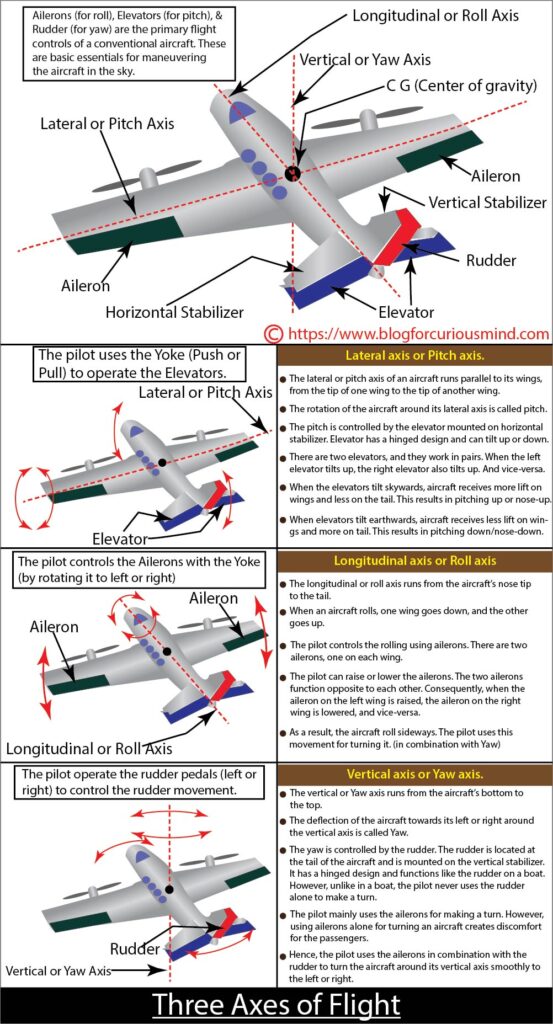
Longitudinal axis or Roll axis
The longitudinal axis of the aircraft runs from its nose tip to the tail. This is also known as the ‘Roll axis.’
What is roll in aircraft
You must have experienced rolling when sailing on a boat. The aircraft makes a rolling movement about its longitudinal axis. When an aircraft rolls, one wing goes down, and the other goes up.
The pilot controls the rolling using ailerons. They have a hinged design and are positioned at the trailing edge of each wing. There are two ailerons, one on each wing.
The pilot can raise or lower the ailerons. The two ailerons function opposite to each other. Consequently, when the aileron on the left wing is raised, the aileron on the right wing is lowered, and vice-versa.
The function of the aileron is to increase the lift on one wing and at the same time reduce the lift on the other. As a result, the aircraft rolls sideways.
The pilot uses the ‘roll’ of the aircraft along with its ‘yaw’ to make a smooth turn.
How a pilot rolls an aircraft
The pilot controls the ailerons with the yoke. The yoke resembles the steering wheel of a car. However, unlike a car steering wheel, a pilot can rotate the yoke to the left and right, and move it forward and backward.
When the pilot rotates the yoke to the left, the left aileron tilts upwards and the right aileron tilts downwards.
This makes the left-wing experience less lift than the right wing. Consequently, the aircraft rolls to its left around the longitudinal axis. The pilot can level the flight by turning the yoke to its center position. The reverse of this happens when the pilot rotates the yoke to the right.
You may watch this YouTube Video (How a pilot uses the Yoke for Roll)
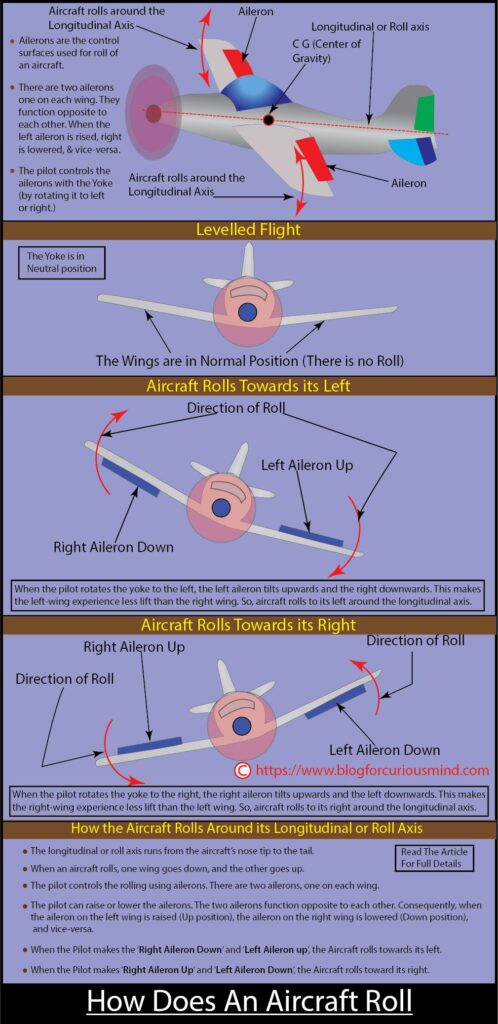
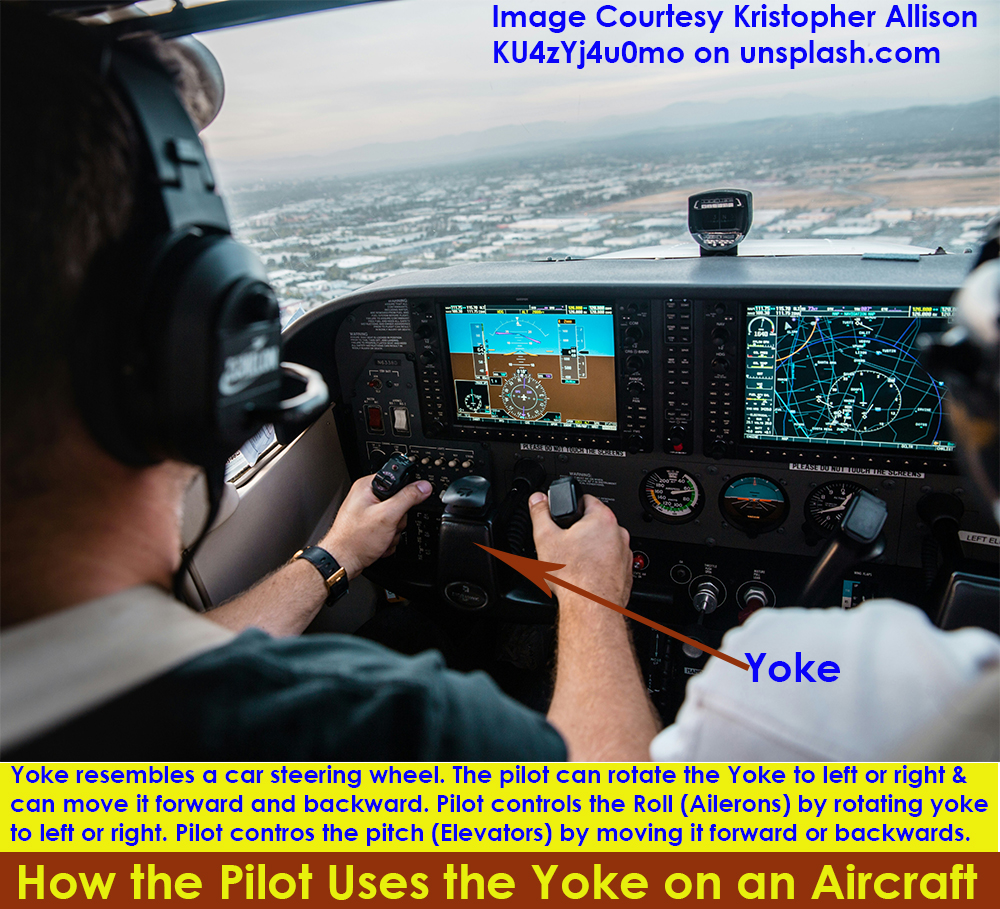
Vertical axis or Yaw axis.
The vertical axis runs from the bottom of the aircraft to its top. This is also known as the ‘Yaw axis.’
What is Yaw on an aircraft
The tilting of the aircraft’s nose towards its left or right around the vertical axis is called Yaw. The yaw is controlled by the rudder.
The rudder is located at the tail of the aircraft, mounted on the vertical stabilizer. It has a hinged design, can tilt to the left or right, and functions like a rudder on a boat. However, unlike in a boat, the pilot never uses the rudder alone to make a turn.
The pilot uses the ‘roll’ of the aircraft along with its ‘yaw‘ to make a smooth turn.
How a pilot yaw an aircraft
The pilot has two rudder pedals on the floor to control the rudder movement. The pilot operates the left pedal to deflect the rudder to the left. Consequently, the aircraft’s nose tilts towards the left (the aircraft twists towards the left).
The pilot operates the right pedal to deflect the rudder to the right. Consequently, the aircraft’s nose tilts towards the right (the aircraft twists towards the right).
The rudder pedals are also used for controlling the aircraft’s movement during taxiing on the runway.
You may watch this YouTube Video (How a pilot uses the rudders for Yaw)
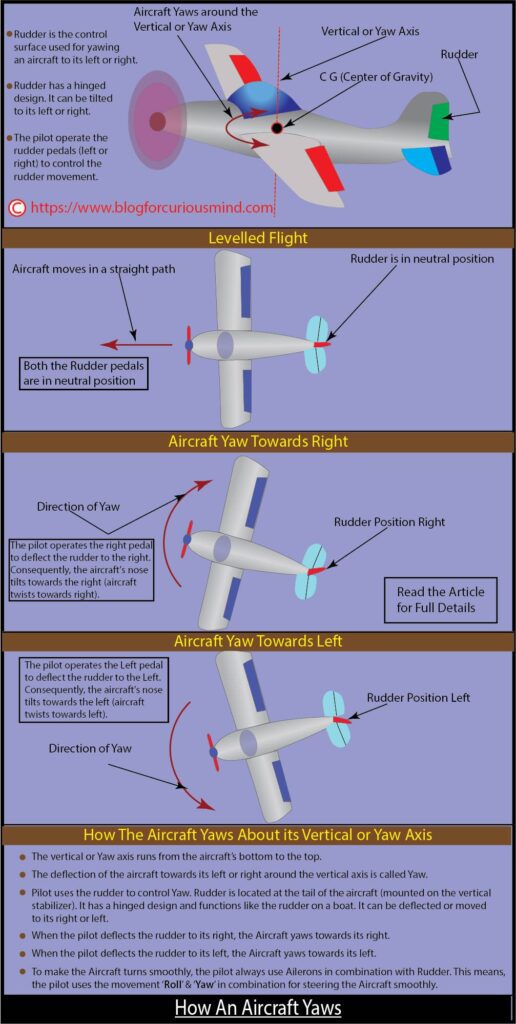
Lateral axis or Pitch axis.
The lateral axis runs parallel to the wings from one wing tip to another wing tip. This is also known as the ‘Pitch axis.’
What is pitch for an aircraft
The rotation of the aircraft around its lateral axis is called pitch. The pitch is controlled by the elevator mounted on the horizontal stabilizer at the tail. The elevator is hinged to the stabilizer and can tilt up or down.
There are two elevators, left and right, and they work in pairs. When the left elevator tilts up, the right also tilts up. Similarly, when the left elevator tilts down, the right also tilts down.
You have seen aircrafts having their nose tilted upwards during climbing and their nose tilted downwards during descent or losing altitude. These movements happen when the aircraft rotates around its pitch axis.
How a pilot pitches an aircraft
The pilot uses the yoke to control the pitch. The pilot pulls the yoke towards him/her to tilt the elevators skywards. Consequently, the aircraft receives more lift on the wings and less on the tail. This results in pitching up of the nose (nose-up).
When the pilot pushes the yoke away, the elevators tilt earthwards. Consequently, the aircraft receives less lift on the wings and more on the tail. This results in pitching down of the nose (nose-down).
You may watch this YouTube video (How a pilot uses the Yoke to Pitch the Aircraft’s Nose Up or Down)
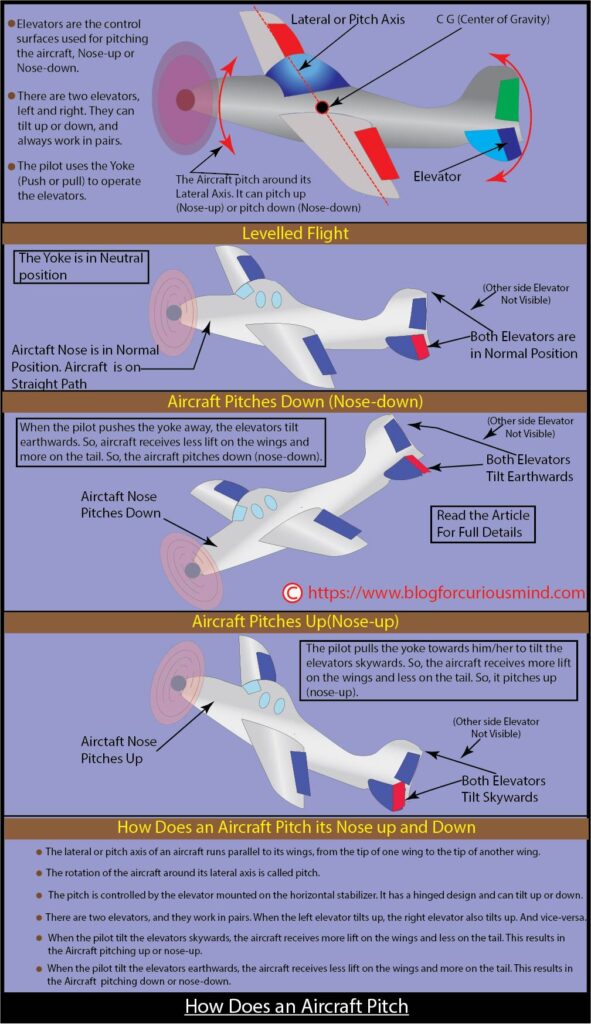
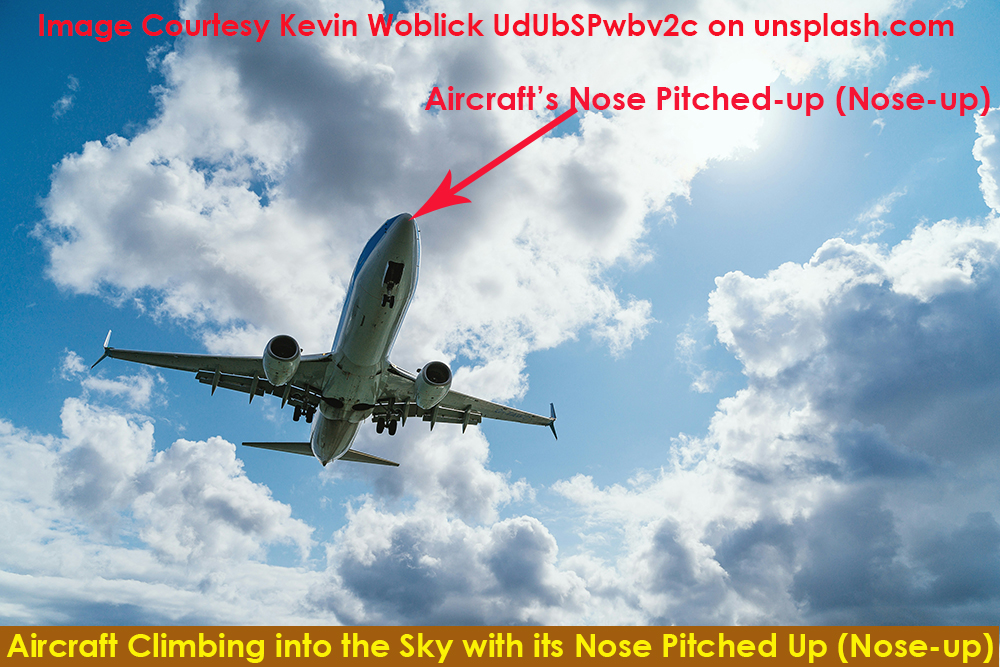
Difference between Yaw and roll
The ‘Yaw’ and ‘roll‘ of an aircraft should not be confused with each other. Yaw refers to the tilting of the aircraft’s nose towards its left or right. On the other hand, a roll indicates a rocking motion towards its left or right (like a boat).
What is banking in an aircraft
The pilot of an aircraft mainly uses the ailerons for making a turn. However, using ailerons alone for turning an aircraft creates discomfort for the passengers sitting in it. Hence, a pilot always uses ailerons in combination with a rudder for effecting a smooth turn.
The use of a rudder offsets the drag created by the aileron’s action when making a turn. When the pilot uses a combination of roll and yaw movements to make a smooth turn, that movement is called ‘banking.’
Conclusion
The three axes of flight and their controls are the primary controls essential for maneuvering all types of aircraft. This is a fascinating subject, is it not? Hope this article was helpful to you.
You may read the article ‘How an Airplane flies.’
You may watch this YouTube Video (How a Pilot Controls Roll, Yaw, and Pitch)
Caution: This article is only for educational purposes. If you are interested in flying an aircraft, please contact a Flying Institute near you and join for formal training.
